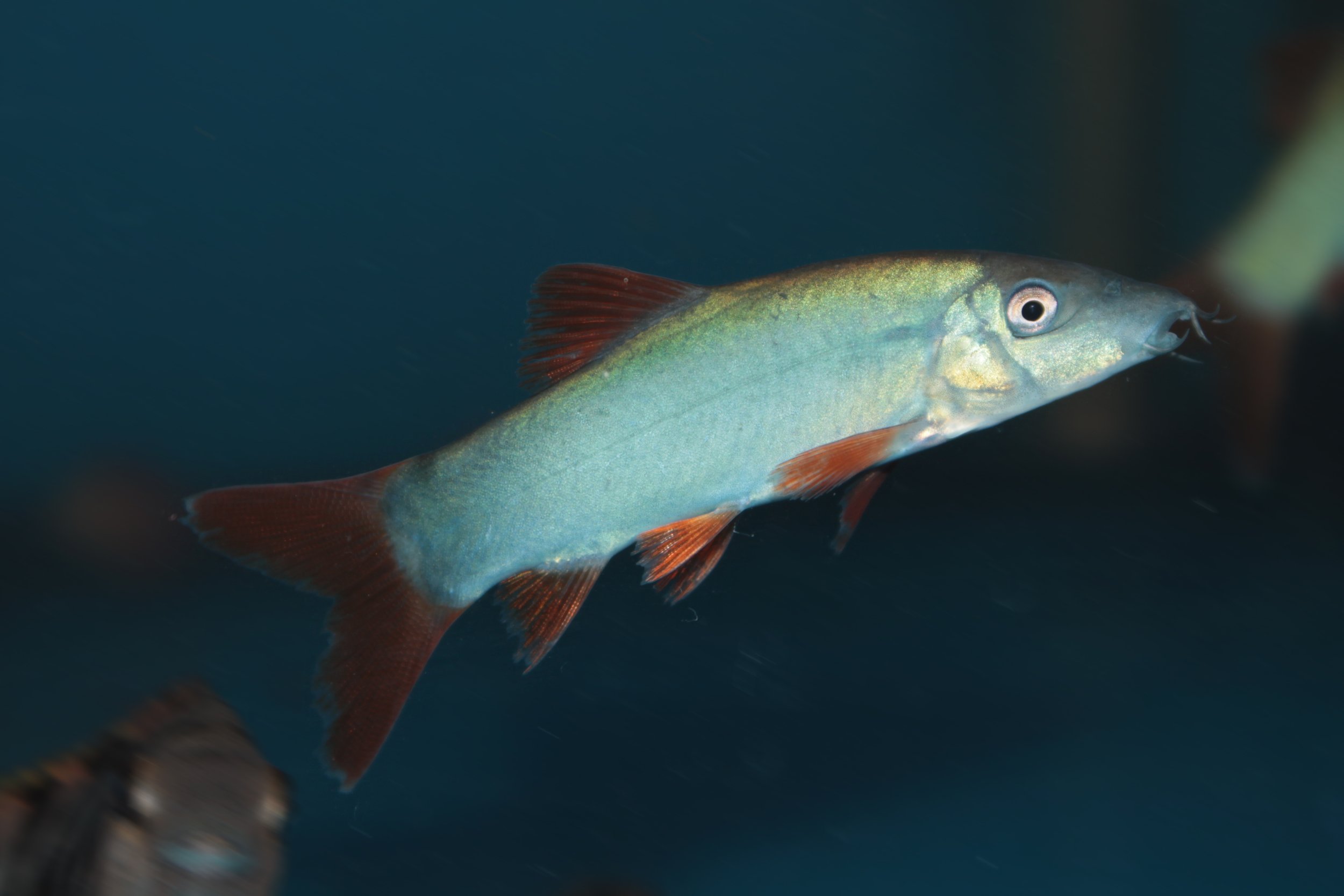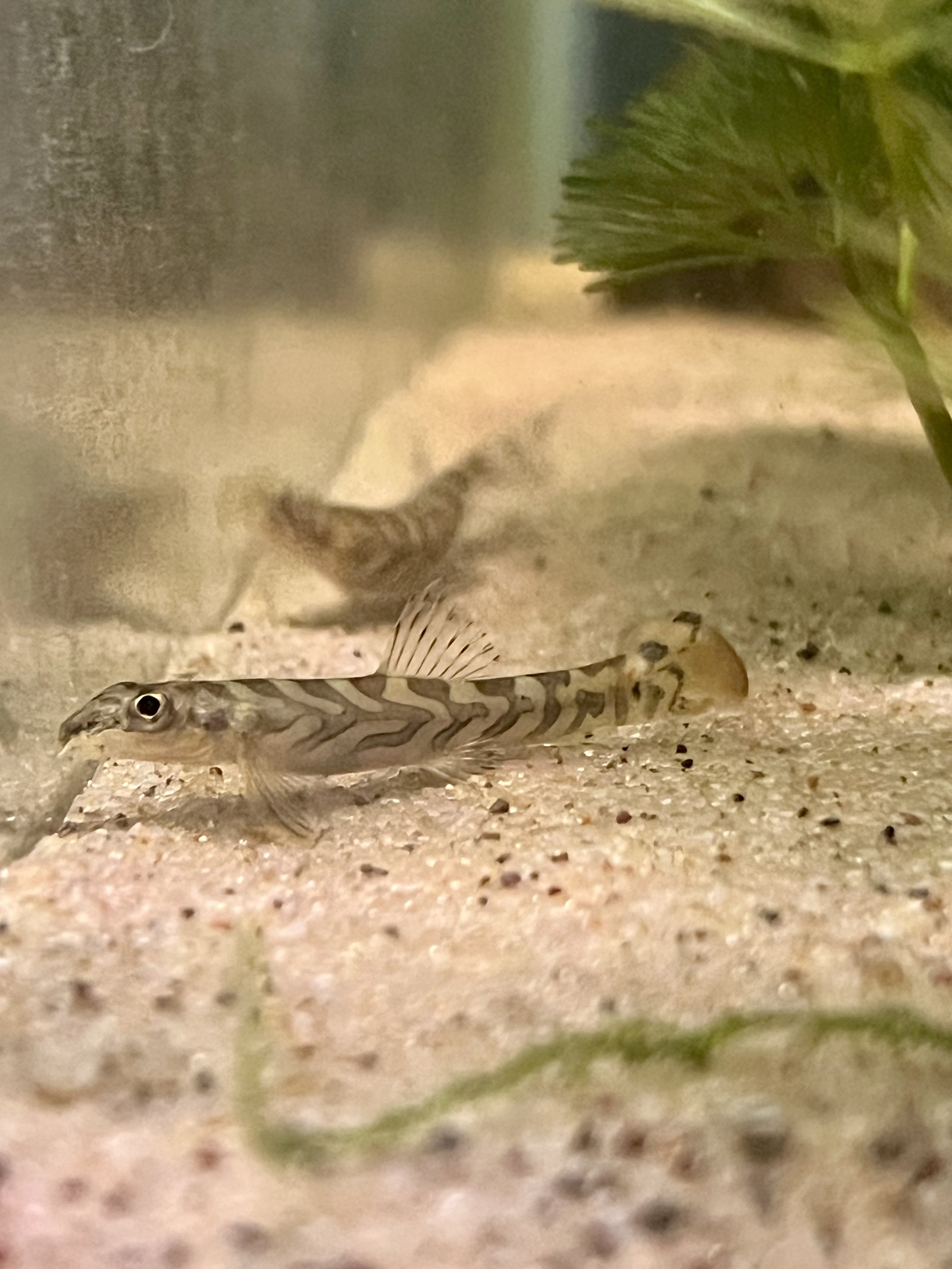 Image 1 of
Image 1 of


Yoyo Loach
The Yoyo Loach, scientifically known as Botia almorhae, is a lively and visually striking freshwater fish native to the slow-moving rivers and streams of northern India, Nepal, and surrounding areas. Known for its playful behavior, distinctive markings, and active nature, the Yoyo Loach is a popular choice for community aquariums. Its name comes from the “yoyo-like” patterns on its body, which resemble the word “YOYO.”
Physically, the Yoyo Loach has a silvery body covered with intricate, dark patterns that vary between individuals. These markings may appear as wavy lines, spots, or a combination of both, creating a unique look for each fish. As the loach matures, its patterns often change, becoming more complex. Its fins are mostly translucent with subtle dark markings. Adult Yoyo Loaches typically grow to about 4 to 6 inches (10 to 15 centimeters) in length, though larger individuals can sometimes reach up to 8 inches (20 centimeters).
In the aquarium, Yoyo Loaches are best kept in groups of at least 4 to 6 individuals, as they are social fish that thrive in the company of their own kind. A tank of at least 40 gallons is recommended, with plenty of hiding spots created using driftwood, rocks, and dense vegetation. They are active bottom-dwellers but will also explore all areas of the tank, so providing open swimming spaces is important. A soft substrate like sand or smooth gravel is ideal to protect their sensitive barbels.
Water parameters for Yoyo Loaches should replicate their natural habitat. They prefer slightly acidic to neutral water with a pH range of 6.0 to 7.5 and temperatures between 75 to 82°F (24 to 28°C). Clean, well-oxygenated water is essential for their health, so regular water changes and efficient filtration are crucial. Moderate water flow mimics their natural riverine environment.
Feeding Yoyo Loaches is easy, as they are omnivorous and have a varied diet. They enjoy high-quality sinking pellets or wafers, supplemented with live or frozen foods such as bloodworms, brine shrimp, and daphnia. They are also known to eat small snails, making them a natural choice for controlling snail populations in the tank. Blanched vegetables like zucchini or cucumber can also be offered as a treat.
Yoyo Loaches are generally peaceful but can exhibit playful aggression among themselves or with similarly sized bottom-dwellers. They are suitable for community tanks with tank mates such as tetras, barbs, rasboras, and gouramis. Avoid housing them with very small or delicate fish, as their active behavior may stress timid species.
Breeding Yoyo Loaches in home aquariums is rare and not well-documented, as they require specific conditions that are difficult to replicate. In the wild, they are seasonal spawners that breed during the rainy season, with environmental triggers such as changes in water temperature and flow playing a key role.
Overall, the Yoyo Loach (Botia almorhae) is a lively and entertaining addition to freshwater aquariums. Its unique patterns, social nature, and ability to help control pest snails make it a favorite among aquarists. With proper care, a suitable environment, and companionship, Yoyo Loaches can thrive and provide endless fascination for both novice and experienced fishkeepers.
The Yoyo Loach, scientifically known as Botia almorhae, is a lively and visually striking freshwater fish native to the slow-moving rivers and streams of northern India, Nepal, and surrounding areas. Known for its playful behavior, distinctive markings, and active nature, the Yoyo Loach is a popular choice for community aquariums. Its name comes from the “yoyo-like” patterns on its body, which resemble the word “YOYO.”
Physically, the Yoyo Loach has a silvery body covered with intricate, dark patterns that vary between individuals. These markings may appear as wavy lines, spots, or a combination of both, creating a unique look for each fish. As the loach matures, its patterns often change, becoming more complex. Its fins are mostly translucent with subtle dark markings. Adult Yoyo Loaches typically grow to about 4 to 6 inches (10 to 15 centimeters) in length, though larger individuals can sometimes reach up to 8 inches (20 centimeters).
In the aquarium, Yoyo Loaches are best kept in groups of at least 4 to 6 individuals, as they are social fish that thrive in the company of their own kind. A tank of at least 40 gallons is recommended, with plenty of hiding spots created using driftwood, rocks, and dense vegetation. They are active bottom-dwellers but will also explore all areas of the tank, so providing open swimming spaces is important. A soft substrate like sand or smooth gravel is ideal to protect their sensitive barbels.
Water parameters for Yoyo Loaches should replicate their natural habitat. They prefer slightly acidic to neutral water with a pH range of 6.0 to 7.5 and temperatures between 75 to 82°F (24 to 28°C). Clean, well-oxygenated water is essential for their health, so regular water changes and efficient filtration are crucial. Moderate water flow mimics their natural riverine environment.
Feeding Yoyo Loaches is easy, as they are omnivorous and have a varied diet. They enjoy high-quality sinking pellets or wafers, supplemented with live or frozen foods such as bloodworms, brine shrimp, and daphnia. They are also known to eat small snails, making them a natural choice for controlling snail populations in the tank. Blanched vegetables like zucchini or cucumber can also be offered as a treat.
Yoyo Loaches are generally peaceful but can exhibit playful aggression among themselves or with similarly sized bottom-dwellers. They are suitable for community tanks with tank mates such as tetras, barbs, rasboras, and gouramis. Avoid housing them with very small or delicate fish, as their active behavior may stress timid species.
Breeding Yoyo Loaches in home aquariums is rare and not well-documented, as they require specific conditions that are difficult to replicate. In the wild, they are seasonal spawners that breed during the rainy season, with environmental triggers such as changes in water temperature and flow playing a key role.
Overall, the Yoyo Loach (Botia almorhae) is a lively and entertaining addition to freshwater aquariums. Its unique patterns, social nature, and ability to help control pest snails make it a favorite among aquarists. With proper care, a suitable environment, and companionship, Yoyo Loaches can thrive and provide endless fascination for both novice and experienced fishkeepers.
The Yoyo Loach, scientifically known as Botia almorhae, is a lively and visually striking freshwater fish native to the slow-moving rivers and streams of northern India, Nepal, and surrounding areas. Known for its playful behavior, distinctive markings, and active nature, the Yoyo Loach is a popular choice for community aquariums. Its name comes from the “yoyo-like” patterns on its body, which resemble the word “YOYO.”
Physically, the Yoyo Loach has a silvery body covered with intricate, dark patterns that vary between individuals. These markings may appear as wavy lines, spots, or a combination of both, creating a unique look for each fish. As the loach matures, its patterns often change, becoming more complex. Its fins are mostly translucent with subtle dark markings. Adult Yoyo Loaches typically grow to about 4 to 6 inches (10 to 15 centimeters) in length, though larger individuals can sometimes reach up to 8 inches (20 centimeters).
In the aquarium, Yoyo Loaches are best kept in groups of at least 4 to 6 individuals, as they are social fish that thrive in the company of their own kind. A tank of at least 40 gallons is recommended, with plenty of hiding spots created using driftwood, rocks, and dense vegetation. They are active bottom-dwellers but will also explore all areas of the tank, so providing open swimming spaces is important. A soft substrate like sand or smooth gravel is ideal to protect their sensitive barbels.
Water parameters for Yoyo Loaches should replicate their natural habitat. They prefer slightly acidic to neutral water with a pH range of 6.0 to 7.5 and temperatures between 75 to 82°F (24 to 28°C). Clean, well-oxygenated water is essential for their health, so regular water changes and efficient filtration are crucial. Moderate water flow mimics their natural riverine environment.
Feeding Yoyo Loaches is easy, as they are omnivorous and have a varied diet. They enjoy high-quality sinking pellets or wafers, supplemented with live or frozen foods such as bloodworms, brine shrimp, and daphnia. They are also known to eat small snails, making them a natural choice for controlling snail populations in the tank. Blanched vegetables like zucchini or cucumber can also be offered as a treat.
Yoyo Loaches are generally peaceful but can exhibit playful aggression among themselves or with similarly sized bottom-dwellers. They are suitable for community tanks with tank mates such as tetras, barbs, rasboras, and gouramis. Avoid housing them with very small or delicate fish, as their active behavior may stress timid species.
Breeding Yoyo Loaches in home aquariums is rare and not well-documented, as they require specific conditions that are difficult to replicate. In the wild, they are seasonal spawners that breed during the rainy season, with environmental triggers such as changes in water temperature and flow playing a key role.
Overall, the Yoyo Loach (Botia almorhae) is a lively and entertaining addition to freshwater aquariums. Its unique patterns, social nature, and ability to help control pest snails make it a favorite among aquarists. With proper care, a suitable environment, and companionship, Yoyo Loaches can thrive and provide endless fascination for both novice and experienced fishkeepers.








